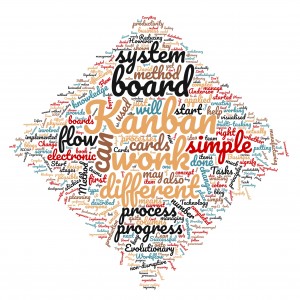 As we said in the last blog, using a Kanban board is not quite as simple as just creating the board. putting cards onto it, then simply moving them around. The Kanban Method, which is outlined by David J Anderson in his book “Kanban: Successful Evolutionary Change for Your Technology Business” outlines a number of principles for managing and improving the flow of work.
As we said in the last blog, using a Kanban board is not quite as simple as just creating the board. putting cards onto it, then simply moving them around. The Kanban Method, which is outlined by David J Anderson in his book “Kanban: Successful Evolutionary Change for Your Technology Business” outlines a number of principles for managing and improving the flow of work.
The Kanban Method
Kanban is described as an evolutionary, non-disruptive method. This sounds complicated, but it basically is a simple principle. Evolutionary means that the idea is to start where you are. Start using the Kanban method directly with the system currently in place. Then small, incremental changes should be made, that will gradually help the system ‘evolve’, promoting gradual improvements to an organization’s processes. These small changes can be suggested and implemented by anyone and, in fact, this should be encouraged. This is why the method is also ‘non-disruptive’ and will avoid resistance within a team or organisation. There is no move to a brand new, wholly different system all at once, with all the associated difficulties of doing that.
Once the Kanban method is effectively applied, it should provide a number of benefits including:
- Improving the flow of work
- Reducing cycle time
- Providing greater predictability
Implementing Kanban
Kanban is implemented by following a number of steps:
- Visualise your Workflow
- Limit work in progress
- Manage Flow
Visualising your Workflow
This is the first and most fundamental step. Work and processes need to visualised on a Kanban Board (this can be physical or electronic). Depending on how complex the work processes and whether there are different work-types involved, the Kanban board may be very simple right through to extremely complex. Once the board is in place, however, the current work of the team or organisation can be clearly visualised.
The cards on the board (again, whether physical or electronic) can be simple, or may be different colours (different types of work, perhaps), or, swim lanes can also be used. It is a good idea to keep the board as simple as possible to start with. The design of the board can evolve and grow, as the work-processes themselves do.
Limit Work-in-Progress.
Once work-flow is visualised, work-in-progress (WIP) should be limited. A team should be encouraged to complete ongoing work before beginning any new work. They should STOP STARTING and START FINISHING. Kanban is a ‘Pull-system’, so new work should only be started when there is capacity to do so and can be ‘pulled’. Setting WIP limits may not be easy at first, but it is possible to start with no WIP limits in place, observe the initial work in progress as a team starts to use Kanban, and then halve the average of each stage (column) of WIP to arrive at a limit.
A WIP Limit is usually 1 to 1.5 times the number of people working in a specific stage. Putting WIP limits on each column helps team members finish what they are doing before starting anything new. It also communicates clearly that there is limited capacity to do work for any team.
Manage Flow
After defining your workflow and limiting WIP, there will either be a smooth flow of work, or work will start to be held up at one or more points. When this happens, the system should be analysed and adjustments made to improve flow, so as to reduce the time it takes to complete each piece of work.
Workflow should be observing to see how long items stay in waiting stages (i.e. “Doing”). Reducing the time spent in these wait stages reduces overall Cycle Time. With improved flow, work becomes smoother and more predictable and reliable commitments can be made to your customers. The main objective is the smooth flow of work from start to completion.
The beauty of Kanban is that it is very simple, but, to work effectively, it requires that its principles be applied in a methodical manner.
Please come back for our next blog which compares online Kanban options.
0 Responses to “The Kanban Method”
Leave a Reply